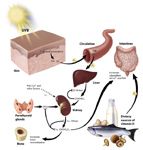Shining light on the vitamin D debate: What the IOM recommendations really mean for your patients
How concerned should you be about vitamin D deficiency in your patients? Here are the findings and recommendations of the 2011 IOM report.
Revelations about the potential health benefits of vitamin D have been flooding scientific and popular information sources. Although it has long been known that vitamin D is critically important for the development, growth, and maintenance of healthy bones, the extraskeletal effects of vitamin D are a more recent focus of research. As new information emerges about potential benefits, there has been growing concern that vitamin D deficiency is common. Questions have been raised about the adverse effects of vitamin D deficiency in children and adolescents, not only in terms of bone health but also in terms of risk for other conditions as well. Yet much remains unknown, including the optimal cutoff values for vitamin D sufficiency, insufficiency, and deficiency in infants and children.
The Institute of Medicine (IOM) recently released its 2011 public health report that provides updated dietary intake requirements for calcium and vitamin D.1 The report also addresses many of the unresolved questions surrounding vitamin D intake.
Vitamin D synthesis, metabolism, and activity

Vitamin D is fat soluble and naturally present in only a few foods. Cholecalciferol is naturally present in oily fish and egg yolks.2,3 Ergocalciferol (vitamin D2) is a plant and yeast sterol found in mushrooms that have been exposed to UV light and is available in some vitamin D supplements.4 In the United States, many foods now are enriched with vitamin D, including milk and some cereals, and dietary supplements containing vitamin D are readily available.1 Infant formulas also include vitamin D.
After entering the general circulation, vitamin D is hydroxylated by enzymes in the liver to 25-hydroxyvitamin D (25OHD or calcidiol), which is further hydroxylated in the kidney to the biologically active metabolite 1,25-dihydroxyvitamin D (1,25-OHD or calcitriol; Figure).2 Compared with calcitriol, 25OHD has a long half-life and exerts minimal feedback inhibition on its own production. For these reasons, 25OHD is used as a measure of body stores of vitamin D.
Vitamin D insufficiency or deficiency leads to a reduction in the efficiency of intestinal calcium absorption and a decrease in serum calcium concentration. Even a small decrease in serum calcium triggers the parathyroid gland to increase synthesis of parathyroid hormone (PTH). Elevated PTH levels will stimulate conversion of 25OHD to calcitriol. This leads to normal or even elevated circulating levels of calcitriol in spite of vitamin D deficiency. Parathyroid hormone also initiates a chain of other signals that ultimately results in the expression of gene products that stimulate the absorption or reabsorption of calcium in the intestines, bone, and kidney. The net result is to increase serum calcium levels.
This is a finely regulated system, so that when the serum calcium normalizes, the PTH-vitamin D axis is downregulated again. In the face of vitamin D deficiency, a persistent secondary hyperparathyroidism leads to increased proliferation of osteoclasts and increased bone resorption. Osteoclast-mediated resorption surpasses osteoblast-mediated bone formation, resulting in decreased bone mineral density.5
The extraskeletal effects of vitamin D, for which the mechanisms are not as well understood as those described above, have been the focus of recent investigation. Vitamin D receptors are expressed in the nucleus of many tissues not involved in calcium and phosphate regulation, such as keratinocytes in the epidermis, and many cells involved with immunity, including activated T cells, antigen-presenting cells, macrophages, monocytes, and cytotoxic T cells.1 Furthermore, calcitriol has been found to regulate hundreds of genes throughout the body.6 Vitamin D also plays a role in cell-mediated immunity.7,8